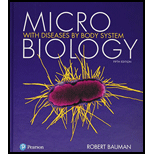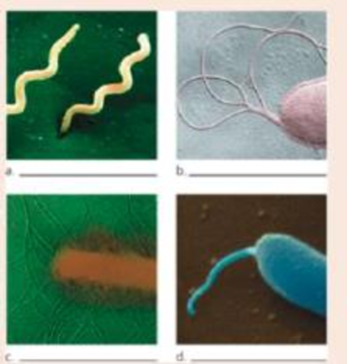
Pearson eText Bauman Microbiology with Diseases by Body Systems -- Instant Access (Pearson+)
5th Edition
ISBN: 9780135891018
Author: ROBERT BAUMAN
Publisher: PEARSON+
expand_more
expand_more
format_list_bulleted
Concept explainers
Textbook Question
Chapter 3, Problem 2VI
Label each type of flagellar arrangement.

Expert Solution & Answer
Want to see the full answer?
Check out a sample textbook solution
Students have asked these similar questions
Use the following tree diagram to answer Questions #8-10.
8) Which of the following two animals
are the most closely related based on the
tree to the left?
a) Pig and camel
b) Hippo and pig
c) Deer and cow
9) CIRCLE on the tree diagram where the
common ancestor between a hippo and a
cow is.
10) Put a SQUARE on the tree diagram
where the common ancestor between a pig
and a peccary is.
Explain:
Healthy Cell Function Overview→ Briefly describe how a healthy cell usually works: metabolism (ATP production), pH balance, glycogen storage, ion transport, enzymes, etc.
Gene Mutation and Genetics Part→ Focus on the autosomal recessive mutation and explain:
How gene mutation affects the cell.
How autosomal inheritance works.
Compare the normal and mutated gene sequences simply. → Talk about possible consequences of a faulty hydrolytic enzyme.
Can you fill out those terms
Chapter 3 Solutions
Pearson eText Bauman Microbiology with Diseases by Body Systems -- Instant Access (Pearson+)
Ch. 3 - Prob. 1TMWCh. 3 - In 1985, an Israeli scientist discovered the...Ch. 3 - Why is a pilus a type of fimbria, but a flagellum...Ch. 3 - Why is the microbe illustrated in Figure 3.2 more...Ch. 3 - The Big Game College sophomore Nadia is a star...Ch. 3 - When the bacterium Escherichia coli is grown in a...Ch. 3 - Prob. 6TMWCh. 3 - Why do scientists consider bacterial and archaeal...Ch. 3 - Why did scientists in the 19th and early 20th...Ch. 3 - Why do some scientists consider archaea, which are...
Ch. 3 - Why are eukaryotic glycocalyces covalently bound...Ch. 3 - Many antimicrobial drugs target bacterial cell...Ch. 3 - Colchicine is a drug that inhibits microtubule...Ch. 3 - A cell may allow a large or charged chemical to...Ch. 3 - Which of the following statements concerning...Ch. 3 - A 9 + 2 arrangement of microtubules is seen in...Ch. 3 - Which of the following is most associated with...Ch. 3 - Which of the following is not associated with...Ch. 3 - Which of the following is true of Svedbergs? a....Ch. 3 - Which of the following statements is true? a. The...Ch. 3 - Prob. 8MCCh. 3 - Bacterial flagella are ______________. a. anchored...Ch. 3 - Prob. 10MCCh. 3 - A Gram-negative cell is moving uric acid across...Ch. 3 - Gram-positive bacteria _______________. a. have a...Ch. 3 - Endospores ________________. a. are reproductive...Ch. 3 - Prob. 14MCCh. 3 - Dipicolinic acid is an important component of...Ch. 3 - Match the structures on the left with the...Ch. 3 - Match the term on the left with its description on...Ch. 3 - Label the structures of the following prokaryotic...Ch. 3 - Label each type of flagellar arrangement.Ch. 3 - A scientist who is studying passive movement of...Ch. 3 - Describe (or draw) an example of diffusion down a...Ch. 3 - Sketch, name, and describe three flagellar...Ch. 3 - Prob. 3SACh. 3 - The term fluid mosaic has been used in describing...Ch. 3 - A local newspaper writer has contacted you, an...Ch. 3 - Prob. 6SACh. 3 - Compare bacterial cells and algal cells, giving at...Ch. 3 - Contrast a cell of Streptococcus pyogenes (a...Ch. 3 - Differentiate among pili, fimbriae, and cilia,...Ch. 3 - Prob. 10SACh. 3 - Prob. 11SACh. 3 - Prob. 12SACh. 3 - What is the function of glycocalyces and fimbriae...Ch. 3 - Prob. 14SACh. 3 - Compare and contrast three types of passive...Ch. 3 - Prob. 16SACh. 3 - Prob. 17SACh. 3 - Prob. 18SACh. 3 - Prob. 1CTCh. 3 - Methylene blue binds to DNA. What structures in a...Ch. 3 - Prob. 3CTCh. 3 - Prob. 4CTCh. 3 - A researcher carefully inserts an electrode into...Ch. 3 - Prob. 6CTCh. 3 - An electron micrograph of a newly discovered cell...Ch. 3 - An entry in a recent scientific journal reports...Ch. 3 - Prob. 9CTCh. 3 - Prob. 10CTCh. 3 - Prob. 11CTCh. 3 - Prob. 12CTCh. 3 - Prob. 13CTCh. 3 - Prob. 14CTCh. 3 - Using the following terms, fill in the following...
Knowledge Booster
Learn more about
Need a deep-dive on the concept behind this application? Look no further. Learn more about this topic, biology and related others by exploring similar questions and additional content below.Similar questions
- Explain down bellow what happens to the cell: Decreased pH in mitochondria Increased ATP Decreased pH in cytosol Increased hydrolysis Decreasing glycogen and triglycerides Increased MAP kinase activity Poor ion transport → For each one:→ What normally happens?→ What is wrong now?→ How does it mess up the cell?arrow_forwardAn 1100 pound equine patient was given 20 mg/kg sucralfate 3 times a day, 2.8 mg/kg famotidine twice a day, and 10mg/kg doxycycline twice a day. Sucralfate comes as a 1 gm tablet, famotidine as 20 mg tablets, and doxycycline as 100mg tablets. All are in bottles of 100 tablets.How many total mg are needed for the patient and how many tablets of each would be needed to provide each dose?How many bottles of each would be needed to have available if this patient were to be on this drug regimen for 5 days?arrow_forwardThe patient needs a solution of 2.5% dextrose in Lactated Ringer’s solution to run at 75 ml/hr for at least the next 12hours. LRS comes in fluid bags of 500 ml, 1 Liter, 3 Liters and 5 Liters. How can a 2.5% solution be made by adding50% dextrose to the LRS?arrow_forward
- “Gretchen” was a 68-pound canine who came to the VMTH as small animal surgery patient. She receivedacepromazine, 0.2 mg/kg from a 10 mg/ml solution and oxymorphone, 0.08 mg/kg from a 1 mg/ml solution before surgery.What are the mechanisms of action of acepromazine and oxymorphone? Why would they be given together?How many mg provide each dose and how many ml of each of these solutions were given?arrow_forwardAfter surgery, “Gretchen” was put on carprofen, 1 mg/pound bid (twice a day). The tablets come in 25, 75 and 100 mgsizes. Which size tablet would be appropriate?What is the mechanism of action of carprofen?An outpatient prescription was written for her so she would have enough for 10 days. How many tablets did she need?What information needs to be on her out-patient prescription?arrow_forwardJoden Koepp olor in chickens is due to incomplete dominance. BB = Black chicken, WW = White BLOOD TYPES Arhite chicken is In humans, Rh positive blood is dominant (R) over Rh negative blood (r). A man with type 0, Rh positive blood (whose mother had Rh negative blood), marries a woman with type AB, Rh negative blood. Several children were born. is? R R Genotypes Phenotypes RRR RR Rr Rr 4/16 RR R RR RK Rr Rr 4/16 rr 3/4 Rh posi 1/4 Rh negu 1/2 Rr rr rr rrrr 88 888 75 e genotype of the man? the genotype of the woman? The mother of the man had type AB blood.arrow_forward
- Please indentify the unknown organismarrow_forward5G JA ATTC 3 3 CTIA A1G5 5 GAAT I I3 3 CTIA AA5 Fig. 5-3: The Eco restriction site (left) would be cleaved at the locations indicated by the arrows. However, a SNP in the position shown in gray (right) would prevent cleavage at this site by EcoRI One of the SNPs in B. rapa is found within the Park14 locus and can be detected by RFLP analysis. The CT polymorphism is found in the intron of the Bra013780 gene found on Chromosome 1. The Park14 allele with the "C" in the SNP has two EcoRI sites and thus is cleaved twice by EcoRI If there is a "T" in that SNP, one of the EcoRI sites is altered, so the Park14 allele with the T in the SNP has only one EcoRI site (Fig. 5-3). Park14 allele with SNP(C) Park14 allele with SNPT) 839 EcoRI 1101 EcoRI 839 EcoRI Fig. 5.4: Schematic restriction maps of the two different Park14 alleles (1316 bp long) of B. rapa. Where on these maps is the CT SNP located? 90 The primers used to amplify the DNA at the Park14 locus (see Fig. 5 and Table 3 of Slankster et…arrow_forwardFrom your previous experiment, you found that this enhancer activates stripe 2 of eve expression. When you sequence this enhancer you find several binding sites for the gap gene, Giant. To test how Giant interacts with eve, you decide to remove all of the Giant binding sites from the eve enhancer. What results do you expect to see with respect to eve expression?arrow_forward
arrow_back_ios
SEE MORE QUESTIONS
arrow_forward_ios
Recommended textbooks for you
 Biology Today and Tomorrow without Physiology (Mi...BiologyISBN:9781305117396Author:Cecie Starr, Christine Evers, Lisa StarrPublisher:Cengage Learning
Biology Today and Tomorrow without Physiology (Mi...BiologyISBN:9781305117396Author:Cecie Starr, Christine Evers, Lisa StarrPublisher:Cengage Learning Biology 2eBiologyISBN:9781947172517Author:Matthew Douglas, Jung Choi, Mary Ann ClarkPublisher:OpenStax
Biology 2eBiologyISBN:9781947172517Author:Matthew Douglas, Jung Choi, Mary Ann ClarkPublisher:OpenStax Biology (MindTap Course List)BiologyISBN:9781337392938Author:Eldra Solomon, Charles Martin, Diana W. Martin, Linda R. BergPublisher:Cengage Learning
Biology (MindTap Course List)BiologyISBN:9781337392938Author:Eldra Solomon, Charles Martin, Diana W. Martin, Linda R. BergPublisher:Cengage Learning Comprehensive Medical Assisting: Administrative a...NursingISBN:9781305964792Author:Wilburta Q. Lindh, Carol D. Tamparo, Barbara M. Dahl, Julie Morris, Cindy CorreaPublisher:Cengage Learning
Comprehensive Medical Assisting: Administrative a...NursingISBN:9781305964792Author:Wilburta Q. Lindh, Carol D. Tamparo, Barbara M. Dahl, Julie Morris, Cindy CorreaPublisher:Cengage Learning

Biology Today and Tomorrow without Physiology (Mi...
Biology
ISBN:9781305117396
Author:Cecie Starr, Christine Evers, Lisa Starr
Publisher:Cengage Learning



Biology 2e
Biology
ISBN:9781947172517
Author:Matthew Douglas, Jung Choi, Mary Ann Clark
Publisher:OpenStax

Biology (MindTap Course List)
Biology
ISBN:9781337392938
Author:Eldra Solomon, Charles Martin, Diana W. Martin, Linda R. Berg
Publisher:Cengage Learning

Comprehensive Medical Assisting: Administrative a...
Nursing
ISBN:9781305964792
Author:Wilburta Q. Lindh, Carol D. Tamparo, Barbara M. Dahl, Julie Morris, Cindy Correa
Publisher:Cengage Learning
Archaea; Author: Bozeman Science;https://www.youtube.com/watch?v=W25nI9kpxtU;License: Standard youtube license